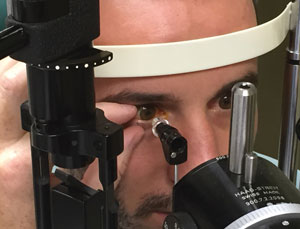 |
For more reliable in-office IOP readings, researchers advise clinicians to have patients sit with eyes at primary gaze for five minutes prior to the measurement, as different postures have varying effects on IOP. Photo: Natalie A. Townsend, OD, and John J. McSoley, OD. Click image to enlarge. |
Fluctuations in intraocular pressure (IOP), particularly over a 24-hour period, are a known contributor to glaucoma progression. Given that research has also shown that IOP readings can be affected by posture, glaucoma patients may potentially be able to reduce IOP fluctuations by adjusting their posture throughout the day, as demonstrated by a recent observational study. It also offers clinicians guidance on improving the reliability of in-office readings by being mindful of patients’ posture.
A total of 74 patients (148 eyes) with open-angle glaucoma participated. Researchers obtained IOP measurements from patients while they were in the following positions: supine, left lateral decubitus, right lateral decubitus, head tilted downwards position with immediate head-up (transient head tilted downwards), seated, seated with head tilted downwards, standing and walking. Patients held each position for five minutes before IOP readings were taken.
Overall, IOP seemed to decrease as elevation of body position increased. Compared with the seated position, IOP was significantly higher with the three sleeping positions—supine, left lateral decubitus, right lateral decubitus—as well as with the patient’s head tilted downwards.
The study authors theorized in their paper that “the decrease in the vertical distance between the eyes and the heart in three different sleeping postures and the head tilted downwards position could lead to an increase in IOP.” They further explained, “The reduction in gravitational potential energy associated with the drainage of aqueous humor into the heart might contribute to the elevation of IOP.”
The researchers also observed that the lateral sleeping position showed a higher IOP than the supine position, which they suggest could be attributed to the fact that “the lateral position requires more gravity to overcome when aqueous humor flows out.”
On the other hand, IOP decreased significantly when standing or walking compared with the seated position (with eyes at primary gaze) or any of the sleeping positions. Additionally, walking decreased IOP levels significantly more than standing.
“The act of standing upright or walking is associated with a temporary reduction in central blood volume, leading to a decrease in cardiac output and mean arterial pressure,” the study authors elaborated in their paper. Further supporting the observed pressure decrease during walking, prior research has also shown that aerobic exercise can reduce IOP.
Based on this data, clinicians may consider recommending their open-angle glaucoma patients to sleep in a lateral position and spend more time standing and walking throughout the day to minimize IOP fluctuations. Additionally, the researchers suggest that during 24-hour IOP monitoring, accurate nighttime measurements should be obtained while patients are in their sleeping postures rather than seated. Lastly, to improve the reliability of in-office IOP readings, the researchers advise clinicians to perform the measurement after a patient has maintained a seated-level gaze position for at least five minutes.
Sang Q, Xin C, Yang D, Mu D, Wang N. Effect of different postures on intraocular pressure in open-angle glaucoma. Ophthalmol Ther. November 4, 2023. [Epub ahead of print]. |

